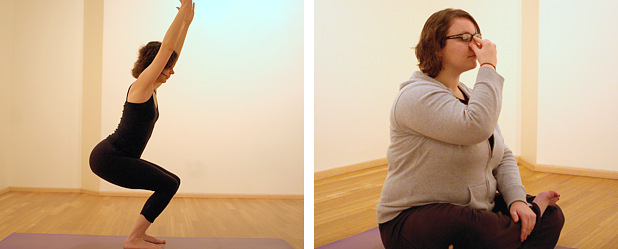I haven’t written much about yoga research lately, mainly because I’ve been heads-down in the book launch events for my second novel. But recently I stumbled across a fact sheet from the National Center for Complementary and Integrative Health that was too good not to pass on.
The article summarizes key facts about yoga, including side effects and risks, recent scientific research, and key points to keep in mind if you are considering starting a yoga practice. As a side bonus, there’s a detailed bibliography of additional articles and links to three videos, one of which includes a list of “dos and don’ts.”
Here are some of my key takeaways:
A carefully designed yoga practice has been proven to:
- Decrease back pain
- Increase range of motion
- Decrease heart rate and blood pressure
- Relieve symptoms of both anxiety and depression
- Improve quality of life and reduce stress
- Reduce insomnia
- Improve overall physical fitness, strength and flexibility
- Be safe for healthy individuals when practiced under the guidance of a well trained-instructor
And a couple of surprises:
- Studies done thus far have not found yoga to be helpful for asthma. (Side note: I wonder how much pranayama—if any—was included. I’d have to look at the full study to weigh in on this.)
- The benefits of yoga for arthritis are equivocal. (Some studies find it helpful, some do not.) Future research is ongoing to see if yoga has different benefits for patients with rheumatoid arthritis versus osteoarthritis. Scientists are also trying to decide if yoga practice may be more helpful for some joints than others.
This sentence, taken directly from the article, almost made my heart sing: “Everyone’s body is different, and yoga postures should be modified based on individual abilities.” This is, of course, the hallmark of Viniyoga. How could I not agree?
Future studies are planned to determine yoga’s effects on a variety of other health conditions, including immune function, diabetes risk, PTSD, and HIV. I can’t wait to see the results!
If you’re at all interested in learning more about yoga, particularly its therapeutic effects, I highly recommend you check out this article. Lots of great information packed into eight very readable pages. Let me know what you think!
Tracy Weber
Come visit Whole Life Yoga in Seattle, and check out Tracy Weber’s author page for information about the Downward Dog Mysteries series. A KILLER RETREAT and MURDER STRIKES A POSE are available at book sellers everywhere!




 This week’s blog entry was written by guest author Rene De los Santos. Rene is a graduate of Whole Life Yoga’s 200 hour yoga teacher training program, a student in our advanced training, and a teacher at Whole Life Yoga. He can be contacted at
This week’s blog entry was written by guest author Rene De los Santos. Rene is a graduate of Whole Life Yoga’s 200 hour yoga teacher training program, a student in our advanced training, and a teacher at Whole Life Yoga. He can be contacted at  This week’s blog entry was written by guest author Sarah Smith. Sarah is a graduate of Whole Life Yoga’s 200 hour yoga teacher training program and a student in our advanced training. She can be contacted at
This week’s blog entry was written by guest author Sarah Smith. Sarah is a graduate of Whole Life Yoga’s 200 hour yoga teacher training program and a student in our advanced training. She can be contacted at 


